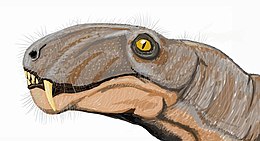Eotitanosuchus
| Eotitanosuchus Temporal range: Wordian,
| |
|---|---|

| |
| Life restoration of Eotitanosuchus olsoni | |
| Scientific classification | |
| Domain: | Eukaryota |
| Kingdom: | Animalia |
| Phylum: | Chordata |
| Clade: | Synapsida |
| Clade: | Therapsida |
| Suborder: | †Biarmosuchia |
| Family: | †Eotitanosuchidae |
| Genus: | †Eotitanosuchus Tchudinov, 1960 |
| Type species | |
| †Eotitanosuchus olsoni Tchudinov, 1960
| |
| Synonyms | |
| |
Eotitanosuchus ("dawn giant crocodile") is an extinct genus of biarmosuchian therapsid whose fossils were found in the town of Ochyor in Perm Krai, Russia. It lived about 267 mya.The only species is Eotitanosuchus olsoni.
Description
Eotitanosuchus known from a single large skull without a lower jaw.Skull 35 cm, overall length may have been over 2.5 meters. Like Biarmosuchus tener, it was primitive in that, though it was a predator, the temple opening behind the eye was small, giving it a weak bite. The temple was, however, larger at the top than in other biarmosuchians.
Paleoecology
Eotitanosuchus fossils were found in the Perm (or Cis-Urals) region of Russia. Eotitanosuchus was without doubt a dominant animal of its environment. Found preserved in flood deposits (once coastal bogs) containing many skeletons of estemmenosuchids, it has been suggested that this large predator was an excellent swimmer, possibly semi-aquatic or frequenting marshy ground. This however is just speculation.
Classification
Eotitanosuchus is often grouped with the Phthinosuchidae and the Biarmosuchidae. In fact, Ivakhnenko (1999) argues that Biarmosuchus tener and Eotitanosuchus olsoni are the same organism, which would eliminate the Eotitanosuchia as a separate taxon, this conclusion does not seem to have been widely accepted. Regardless of the eventual outcome of this debate, Ivakhnenko's paper does seem to show that Eotitanosuchus is very similar to Biarmosuchus. Further, given the rather close similarity between Eotitanosuchus and later therapsids, this observation supports the view that Biarmosuchia is paraphyletic. Others view Eotitanosuchus as quite distinct from other basal therapsids and perhaps closer to the Gorgonopsia but gorgonopsian specializations are either not present in Eotitanosuchus or, as is more often the case, the state of the characters is unknown. This genus is characterized by many primitive features of the septomaxilla, the postorbital, the parietal, the interparietal, the basioccipital, the quadrate rami of the pterygoid and the vomers of the skull. The length of the dorsal process of the premaxilla (front jawbone) and the postorbital twisting (rear side of the skull) constitute specializations that indicate it is not a direct gorgonopsian ancestor. These features however are shared by the anteosaur and biarmosuchid lineages.
See also
References
- Chudinov, P. K. 1965, "New Facts about the Fauna of the Upper Permian of the USSR", Journal of Geology, 73:117-30
- Olsen, E. C., 1962, Late Permian terrestrial vertebrates, USA and USSR Transactions of the American Philosophical Society, new series, 52: 1–224.
- Patricia Vickers-Rich and Thomas H. Rich, The Great Russian Dinosaurs, Gunter Graphics, 1993, Pg 28.
External links
- Eotitanosuchidae at Kheper
- Eotitanosuchidae
- Therapsida: Biarmosuchia: Biarmosuchidae / Eotitanosuchidae at Palaeos
- Therapsida: Biarmosuchia at Palaeos


